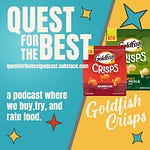On today’s quest we are trying out different varieties of nuts! Now, we know that when talking about nuts, people can get the giggles. People can take everything you say the wrong way. But I assure you, we kept this as professional as possible. Just to be clear, we are discussing the nuts that grow in nature, that you can buy at the grocery store, and come in varieties such as almond, pecan, and so on. So, get your mind out of the gutter.
Which nuts are we trying today?
Pecan
Almond
Cashew
Peanut
Brazil Nut
Who is on this double entendre quest?
Hannah, here under protest
Nate, likes an ugly nut
Matt, likes his nuts candied
Amy, can smell your nuts from here.
And of course, our subscribers! Thanks to our small, yet coveted group. We appreciate the support. You too can join us on this food journey. All you need to do is… SUBSCRIBE!
The History of Nuts
Nuts have been around a long time. From prehistoric man to your average joe of today, nuts have been a food source throughout history. Nuts were one of the first convenience foods, meaning they could be carried easily, stored for months at a time, and were rich in fat and protein, making them filling.
There is a lot of history when it comes to nuts. So to shorten this down, I have a little mini history for each nut we are trying today.
Pecans originated in central and eastern North America and the river valleys of Mexico. In fact, pecans are the only major tree nut that grows naturally in North America. The U.S. produces between 80-90% of the world’s pecans, with an annual crop of about 300 million pounds.
Almonds were a dietary staple of the ancient people of the Middle East. The Romans were the first to make candied almonds, which they often gave as wedding presents as a symbol of fertility. During the Middle Ages, they were ground into flour and used for almond milk. And almond oil was used for medicine in European and Middle Eastern cultures. Today the state of California is the biggest producer of almonds, growing approximately 80% of the world’s supply.
The Cashew tree is native to tropical regions of Brazil. The tree produces a long fleshy stalk, called a cashew apple. And at the end of this stalk grows the kidney-shaped cashew nut. The nuts are encased in a double shell that contains the same toxic compound found in poison ivy, poison oak, and poison sumac. This is why cashews are not sold in their shells. They are typically dry roasted, which rids the nut of toxic oils. But despite the poison, cashews have the highest magnesium content per serving of any tree nut.
Peanuts are native to the Western Hemisphere and originating in South America. They spread throughout the New World as Spanish explorers discovered the versatility of the nut. There were some commercial peanut farms in the U.S. during the 1700s and 1800s, but they were regarded as a poor food due to how labor intensive it was to harvest. After the Civil War, the demand increased rapidly and in the twentieth century, labor-saving equipment saw the rise in demand for the peanut and peanut products.
Brazil Nuts are found throughout the Amazon rain forest. The trees grow in lowland rain forests where flooding isn’t prevalent and can live for 500 years or longer. The Brazil Nut is actually considered a seed since they come in large pods. They are actually related closer to blueberries than walnuts or pecans. Each pod can weigh up to 5 ½ pounds and can drop from the height of an 18 story high-rise building, hurtling towards the ground at 50 mph. Today, nearly half the Brazil Nuts imported to the United States come from Bolivia.
The most consumed nut in the world is the Peanut at 42.6 million metric tons.
The peanut is followed by…
Almonds
Walnuts
Cashews
Pistachio
Hazelnut
Pecan
Macadamia
Brazil Nut
Pine Nut
The Results
**SPOILER ALERT!**
Listen to the episode first if you do not want the results revealed to you yet!
5th Place: Brazil Nut
Amy - 2
Hannah - 1
Matt - 5
Nate - 5
4th Place: Pecans
Amy - 5
Hannah - 2
Matt - 4
Nate - 6
3rd Place: Peanuts
Amy - 6
Hannah - 3
Matt - 6
Nate - 3
1st/2nd Place (Tie!): Almonds
Amy - 4
Hannah - 4
Matt - 7
Nate - 4
1st/2nd (Tie!): Cashews
Amy - 8
Hannah - 1
Matt - 3
Nate - 7
There you have it. Almonds and Cashews receive the Quest for the Best seal of approval.
Thank you all for joining us on this episode of Quest for the Best. Let us know what you thought. Have you tried all these? We would love to hear your rating as well.
Also, do you have any foods you would love to get the coveted seal of approval? Let us know in the comments what you want to hear next.
And of course, remember to subscribe to hear the latest episodes. Additionally, paid subscribers will have access to monthly content where we put two restaurants head to head in a Quest for the Best battle. You definitely do not want to miss out.
SHOW NOTES:
https://recipes.howstuffworks.com/history-of-nuts.htm
https://www.almonds.com/why-almonds/global-history
https://www.livescience.com/46602-where-do-cashews-come-from.html
https://www.statista.com/statistics/1030815/tree-nut-global-consumption-by-type/


















Share this post